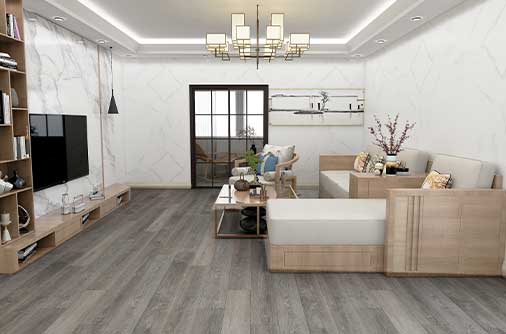In modern home and commercial space design, the choice of floor materials directly affects the overall beauty, comfort and service life. As a floor decoration material that has rapidly emerged in recent years, dry-back LVT (Luxury Vinyl Tile) has won wide favor from designers and consumers with its unique structural design and excellent performance.
Structural analysis of dry-back LVT flooring
Dry-back LVT flooring is a special form of luxury vinyl flooring. Its "dry back" means that there is no adhesive layer or foam padding on the back, and the back remains dry and hard. This structure requires it to be fixed with a special adhesive during installation, or a floating paving method is used.
The core layer of dry-back LVT usually uses high-density vinyl material, which has good wear resistance and elasticity, ensuring that the floor surface remains bright in color and delicate in texture during long-term use. The surface is usually covered with a scratch-resistant transparent protective film, which makes it extremely stain-resistant and wear-resistant, suitable for the use needs of various complex environments.
The difference between dry-back LVT and other types of LVT
Compared with traditional LVT with adhesive or foam backing, dry-back LVT pays more attention to the flexibility of installation and the requirements of ground flatness. Although LVT with adhesive backing is easy to install quickly, it has low requirements for the base layer and is prone to warping and bulging; while dry-back LVT is dry and hard on the back, so it is more suitable for projects with high standards for base layer flatness, ensuring the overall flatness and stability after installation.

Dry-back LVT performs well in maintenance, is not easy to accumulate dust and dirt, and is more convenient when replacing parts, which meets the needs of modern space for flexibility and maintenance convenience.
Installation process and construction points
The installation process of dry-back LVT requires rigorous base layer treatment to ensure the flatness and firmness of the floor after installation. The base layer surface must meet the standards of dust-free, dry and flat. Professional base layer inspection and repair are required before construction to prevent the floor from undulating and falling off after installation due to base layer defects.
Dry-back LVT is usually installed by full-paving gluing or local gluing. The glue selection needs to meet environmental protection and durability standards to ensure strong bonding between the floor and the base layer without affecting the indoor air quality. During the installation process, workers must strictly control the temperature and humidity environment to avoid deformation or dimensional errors of the material due to environmental changes.
Performance advantages of dry-back LVT
From a performance perspective, dry-back LVT has many advantages. Its excellent wear-resistant layer design enables it to withstand frequent personnel flow in commercial spaces and homes and keep the floor beautiful. The elastic structure of the vinyl material gives the floor a good cushioning effect, improves foot comfort and reduces fatigue.
Dry-back LVT has good waterproof performance and is suitable for use in humid environments such as kitchens and bathrooms. It also has strong resistance to chemical corrosion, can resist the erosion of daily detergents, has low maintenance costs, and is easy to clean and maintain.
In terms of environmental adaptability, dry-back LVT has good resistance to temperature differences and ultraviolet rays, is not easy to fade and deform, and is suitable for use in a variety of climatic conditions. This feature makes it highly competitive in both domestic and foreign markets.
Design and Aesthetics
Dry-back LVT flooring breaks through the limitations of traditional vinyl flooring in design. Through high-precision digital printing technology, it can achieve a variety of textures and patterns, including wood grain, stone texture, metal texture, etc., to meet the visual needs of different styles of space.

Due to the transparent protective film on the surface, the floor surface has a natural luster and delicate texture, which can create a realistic natural material visual effect, and is scratch-resistant and stain-resistant. Designers can flexibly choose different textures and color combinations to create personalized spaces based on the function and aesthetic needs of the space.
Dry-back LVT flooring has become an indispensable main force in the field of modern floor decoration with its unique structural design and excellent performance advantages. Whether it is a commercial project or a high-end residential space, dry-back LVT can provide a stable, durable and visually excellent floor solution. With people's continuous pursuit of quality of life, dry-back LVT will play a more important role in the future flooring market.


 English
English 中文简体
中文简体 русский
русский Español
Español




